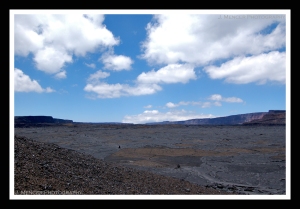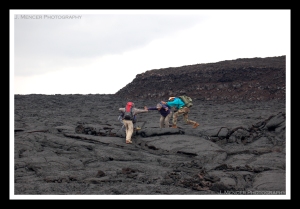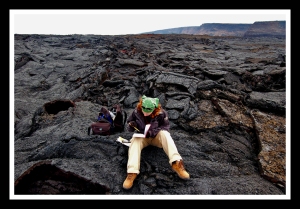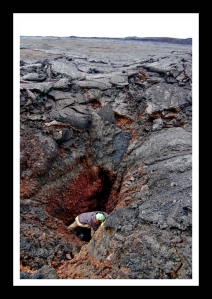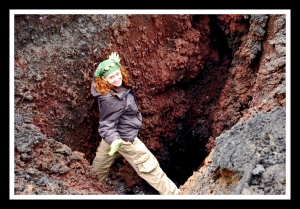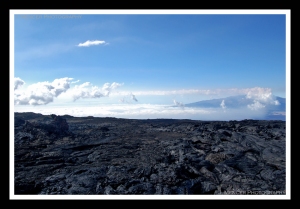I’m going to apologize in advance for today’s pictures. They’re just fun ones, and certainly not my best work. A few weren’t even taken by me. I had such a long day (left the house at 5:40AM and returned at 8PM) that it’s all I can do to keep my eyes open and my fingers on the keys. Also, today’s pictures were just plain FUN.
I met my boss and 3 other geologists at his house at 6AM. We headed into Hilo for coffee before heading up the Saddle Road to Mauna Loa. If you click that link you can learn quite a bit about the mountain. For anyone who doesn’t click, the brief details are as follows: Mauna Loa is 13,679 feet (4,169 meters) tall. That’s just the part that’s visible outside of the ocean. It is the largest mountain in the world when measured from its true base on the seafloor, and is an active volcano. The last eruption occurred in 1984 and made the news all over the world.
We drove as far as we could along a twisty, bone-jarring road littered with lava. Actually, the road was made of lava. Four wheel drive was absolutely necessary. After we’d reached our limit with the car we hiked up to Mokuaweoweo, the caldera. Here you can see the lava remaining from the 1984 eruption as well as the high points along the rim of the caldera. The middle is lower because the volcano’s top collapsed in on itself.
The lava in the caldera formed a lake of fire. Pretty impressive. Ok, here’s where the post gets silly.
I assure you that these four men are all professional geologists employed by either universities or the US Geological Survey. They are also wise in the ways of the rock gods. Ok, I’m just kidding. What we were doing in the caldera was collecting samples from lava flows of varying ages for Chlorine-36 dating. The simple explanation is that the sun’s rays penetrate rocks and react with minerals that are stored inside of the rocks. This creates a radioactive form of Chlorine. It is not stable, and that means that Cl-36 wants to change forms. You can measure the amount of Cl-36 in a rock to determine how old the rock is. It’s similar to Carbon-14 dating, if you’ve heard of that.
In that picture, the geologists were clowning around while taking a picture of the horizon with a fisheye camera lens. Geologists have a good sense of humor, so just take my word for it when I say that we really were working hard. In addition to the photographs, we also had to use GPS devices to pinpoint our locations, collect samples for the actual dating, and take horizon measurements with a Brunton compass. We measured flows ranging in age from 1832 to 1984.
In this photo Yours Truly is demonstrating how to erase mistakes made while writing field notes.
Note the awesome lava I’m sitting on. What was I so diligently taking notes on, you wonder? Well, if I told you it was a very large volcanic vent I wouldn’t be lying.
I was looking at the side of the vent with a hand lens (or loupe). I was suspending myself 20 feet below the surface of the caldera. I went down a bit further, but the vent kept going. It was definitely over 50 feet deep, and I couldn’t see the bottom. I had to brace myself against the walls in order to stay safe. The primary researcher on the Cl-36 project collected a sample from inside the vent, so we weren’t just goofing off. This vent was part of the 1984 eruption. It’s very disconcerting to be standing on rock that is younger than you are. Ok, one more for good measure (and because going down in there was so incredibly invigorating).
Can you tell I was having a blast? The caldera floor emitted quite a bit of steam, so the reminder of what, exactly, I was in was lodged in the back of my mind.
After a long day of hiking, sample collecting, and vent exploring, I returned to the truck to see this view of Mauna Kea.
I’m going to go pass out since I’m drained and tomorrow may mean more field work. Wednesday is field work for sure, so I’ll need all the energy I can muster over the next few days.
